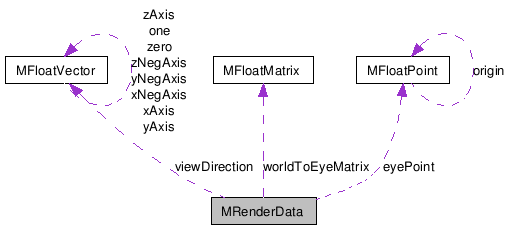MRenderData Class Reference
[OpenMayaRender - API module for
rendering]
#include
<MRenderData.h>

Detailed Description
Access Rendering Data.The rendered image and depth map can be changed following the software render by instanciating a MRenderCallback and overriding renderCallback() or postProcessCallback(). When these methods are invoked, a MRenderData is passed as an argument; the rgbaArr and depthArr can then be changed by this API. Methods and data are provided to assist in transforming back and forth from world space to image space. Paint Effects and Fur are two examples which use this mechanism to change the rendered image.
Public Member Functions |
|
| MRenderData () | |
| void | worldToScreen (const MFloatPoint &worldPoint, MFloatPoint &screenPoint) const |
| void | screenToWorld (const MFloatPoint &screenPoint, MFloatPoint &worldPoint) const |
Public Attributes |
|
| bool | perspective |
| set if the camera has a perspective
projection |
|
| unsigned short | resX |
| the x resolution of the rendered
image |
|
| unsigned short | resY |
| the y resolution of the rendered
image |
|
| unsigned short | left |
| the left (low) render region
dimension |
|
| unsigned short | bottom |
| the bottom (low) render region
dimension |
|
| unsigned short | right |
| the right (high) render region
dimension |
|
| unsigned short | top |
| the top (high) render region
dimension |
|
| unsigned short | bytesPerChannel |
| number of bytes per channel of the
rgbaArr |
|
| unsigned short | xsize |
| the actual x resolution of rgbaArr and
depthArr |
|
| unsigned short | ysize |
| the actual y resolution of rgbaArr and
depthArr |
|
| float | fieldOfView |
| camera horizontal field of view in
radians |
|
| float | aspectRatio |
| camera pixel aspect ratio |
|
| MFloatVector | viewDirection |
| view direction of the camera (object
space) |
|
| MFloatPoint | eyePoint |
| position of the camera (object
space) |
|
| MFloatMatrix | worldToEyeMatrix |
| camera matrix to transform to eye
space |
|
| unsigned char * | rgbaArr |
| float * | depthArr |
Constructor & Destructor Documentation
| MRenderData::MRenderData | ( | ) |
Default class Constructor
Member Function Documentation
| void MRenderData::worldToScreen | ( | const MFloatPoint & | inPoint, | |
| MFloatPoint & | outPoint | |||
| ) | const |
Converts world space point to screen space. Screen depth is stored in outPoint.z.
- Parameters:
-
[in] inPoint The original point in world space [out] outPoint The converted point in screen space
| void MRenderData::screenToWorld | ( | const MFloatPoint & | inPoint, | |
| MFloatPoint & | outPoint | |||
| ) | const |
Converts screen space point to world space. Screen depth is stored in inPoint.z.
- Parameters:
-
[in] inPoint The original point in screen space [out] outPoint The converted point in world space
Member Data Documentation
| unsigned char* MRenderData::rgbaArr |
this is a 1d array representing the output image buffer. It is of size: resX * resY * 4 * bytesPerChannel. The array is indexed as [(resX * x + y) * 4 * bytesPerChannel], where (x,y) is the current pixel coordinates. The "4" multiplier is used for storing RGBA information, in the order of a,b,g,r (on OSX) or b,g,r,a (on Windows and Linux).
| float* MRenderData::depthArr |
this is a 1d array representing the output depth buffer. It is of size: resX * resY, where each depth value is a single precision floating point vlue. It is indexed as [resX * x + y], where (x,y) is the current pixel coordinates.